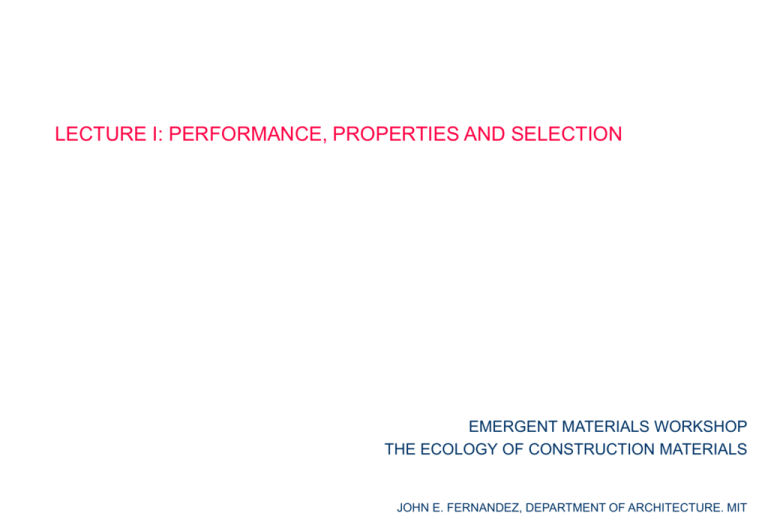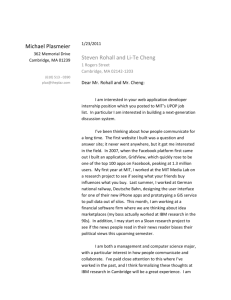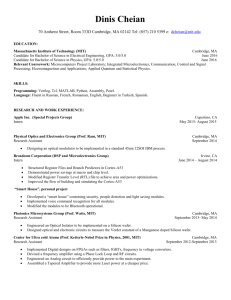LECTURE I: PERFORMANCE, PROPERTIES AND SELECTION
advertisement

LECTURE I: PERFORMANCE, PROPERTIES AND SELECTION EMERGENT MATERIALS WORKSHOP THE ECOLOGY OF CONSTRUCTION MATERIALS JOHN E. FERNANDEZ, DEPARTMENT OF ARCHITECTURE. MIT PERFORMANCE • Complex system: materials components, assemblies, devices, building systems • Complex process: extraction, refining, processing, manufacturing, construction • Inception, life cycle PROPERTIES • Material properties: intrinsic, extrinsic • Material families 1. Metals 2. Polymers 3. Ceramics 4. Composites 5. Natural materials SELECTION Current process Analogs for design Methodologies of selection JOHN E. FERNANDEZ, DEPARTMENT OF ARCHITECTURE. MIT •Complex system: materials components, assemblies, devices, building systems •Complex process: extraction, refining, processing, manufacturing, construction •Inception, life cycle References Basalla, George. (1988) The Evolution of Technology. Cambridge University Press, Cambridge, UK. Beukers, Adriaan van Hinte, Ed (1998) Lightness: the inevitable renaissance of minimum energy structures. 010 Publishers, Rotterdam. Cowan, Henry J., Smith, Peter R. (1988) The Science and Technology of Building Materials. Van Nostrand Reinhold, New York. Daniels, Klaus (1997) The Technology of Ecological Building, Basic Prinicples and Measures, Examples and Ideas. Birkhauser, Munich. Daniels, Klaus (1998) Low-Tech LightTech High-Tech, Building in the Information Age. Birkhauser, Munich. Gregotti, Vittorio (1996) Inside Architecture. The MIT Press, Cambridge. Peters, Tom F. (1996) Building the Nineteenth Century. MIT Press, Cambridge. Turner, R. Gregory (1986) Construction Economics and Building Design. Van Nostrand Reinhold, New York. •Complex system: materials components, assemblies, devices, building systems •Complex process: extraction, refining, processing, manufacturing, construction •Inception, life cycle References Alberti, Leon Battista. [1550] 1999. On the Art of Building in Ten Books, Cambridge: MIT Press. Ford, Edward. 1996. Details of Modern Architecture, Volume 2. Cambridge: MIT Press. Strike, James. 1991. Construction into Design, The Influence of New Methods of Construction on Architectural Design, 1690-1990. Butterworth-Heinemann Ltd, Oxford. Holton, Gerald (1996) On the Art of Scientific Imagination. In: Managing Innovation. Dadalus, Journal of the American Academy of Arts and Sciences, Spring 1996, pp.183-208. National Materials Advisory Board (2000) Materials in the New Millenium: Responding to Society’s Needs. National Academy Press, Washington, DC. Moavenzadeh, Fred ed. 1990. Concise Encyclopedia of Building & Construction Materials. Cambridge, MIT Press. •Complex system: materials components, assemblies, devices, building systems •Complex process: extraction, refining, processing, manufacturing, construction •Inception, life cycle References Adriannse, A. Bringezu, S. Hammond, A. Moriguchi, Y. Rodenburg, E. and others (1997) Resource flows - The material basis of industrial economies. World Resource Institute, Washington D.C. Ayers, R.U. (1994) Industrial Metabolism: Theory and Policy. In: The Greening of Industrial Ecosystems, National Academy Press, Washington, DC:pp. 23-37. Formoso, C.T. Soibelman L. De Csare, C. Isatto, E.L. (2002) Material waste in building industry: main causes and prevention. Journal of ConstructionEngineering and Management, Vol.128, No.4: pp.316-325. Geiser Kenneth. 2001. Materials Matter: towards a sustainable materials policy. MIT Press. Cambridge, Massachusetts. 2001. Mikesell RF. 1995. The limits to growth, a reappraisal. Resources Policy 21(2): 127131. Matos, G. Wagner, L. (1998) Consumption of Materials in the United States, 19901995. USGS Report, Denver. •Complex system: materials components, assemblies, devices, building systems •Complex process: extraction, refining, processing, manufacturing, construction •Inception, life cycle References Kotaji, S. Schuurmans, A. Edwards, S. (2003) Life-Cycle Assessment in Building and Construction, SETAC North America, Raleigh, USA. Wernick I.K. Herman, R. Govind S. Ausubel J.H. (1996) Materialization and Dematerialization: Measures and Trends. In: The Liberation of the Environment. Dadalus, Journal of the American Academy of Arts and Sciences. Summer 1996, pp. 171-197. Smith S.D. (2003) USGS Statistical Summary. United States Geological Survey, March 2003. •Complex system: materials components, assemblies, devices, building systems •Complex process: extraction, refining, processing, manufacturing, construction •Inception, life cycle JOHN E. FERNANDEZ, DEPARTMENT OF ARCHITECTURE. MIT • Material properties • Material families JOHN E. FERNANDEZ, DEPARTMENT OF ARCHITECTURE. MIT Material properties: • Intrinsic • mechanical • physical • Extrinsic References Moavenzadeh, Fred, Editor (1990) Concise Encyclopedia of Building & Construction Materials. Pergamon, Oxford, UK. A: aluminum B: brick C: concrete G: glass P: polymers R: copper S(n): steel, non residential S(r): steel W(n): wood, non-residential W(r): wood, residential Sources: various JOHN E. FERNANDEZ, DEPARTMENT OF ARCHITECTURE. MIT US materials use in construction Material properties: • Intrinsic • mechanical • physical • References CES InDepth And previous Ashbby pubs Extrinsic For metals, the compressive strength is the same as the tensile yield strength. Polymers are approximately 20% stronger in compression than in tension. Foams are linearly elastic up to a strain of between 0.5 and 5%. Beyond the elastic limit the stress-strain curve has a much lower slope: low density foams have an almost horizontal plateau; denser ones have a rising stress-strain curve. The database stores three measures of the compressive strength. The first is the stress at a compressive strain of 5% (roughly, at the elastic limit in compression), the second is the stress at 25% strain (roughly the middle of the plateau) and the last is the stress at 50% strain (the end of the plateau). For ceramics, compressive strength is governed by crushing and is much larger than the tensile strength . Typically Composites which contain fibres (including natural composites like wood) are a little weaker (up to 30%) in compression than tension because the fibres buckle. For continuous fibre, polymer composites, where no data was available, the compressive strength was calculated using the Maximum Stress Failure Criteria (see [44]). Wood, often, is used to support compressive loads: railway sleepers, pallets, frames of buildings, packaging for heavy objects are examples. The compressive strength is important in such applications. Three strength properties of woods are widely reported (Forest Product Laboratory [27]:the compressive crushing-strength, sc, the modulus of rupture (or bending-strength) sMOR, and the shear-strength parallel to the grain, t||. We define these first, before going on to the elastic limit, tensile strength and endurance limit which were frequently estimated from them to make the database. JOHN E. FERNANDEZ, DEPARTMENT OF ARCHITECTURE. MIT Material properties - > families: References Ashby Michael F. Jones David RH. 2001. Engineering Materials I: an introduction to their properties and applications. Butterworth-Heinemann. 2001 JOHN E. FERNANDEZ, DEPARTMENT OF ARCHITECTURE. MIT Material families: • Metals • Polymers • Ceramics • Natural • Composites References Ashby Michael F. Jones David RH. 2001. Engineering Materials I: an introduction to their properties and applications. Butterworth-Heinemann. 2001 JOHN E. FERNANDEZ, DEPARTMENT OF ARCHITECTURE. MIT Material families: • Metals • ferrous References Ashby Michael F. Jones David RH. 2001. Engineering Materials I: an introduction to their properties and applications. Butterworth-Heinemann. 2001 Approximate dates of discovery for the seven metals of antiquity gold 6000BC copper 4200BC silver 4000BC lead 3500BC tin 1750BC iron, smelted 1500BC mercury 750BC JOHN E. FERNANDEZ, DEPARTMENT OF ARCHITECTURE. MIT Material families: • Metals • nonferrous References Ashby Michael F. Jones David RH. 2001. Engineering Materials I: an introduction to their properties and applications. Butterworth-Heinemann. 2001 JOHN E. FERNANDEZ, DEPARTMENT OF ARCHITECTURE. MIT Material families: • Metals • alloying metals References Ashby Michael F. Jones David RH. 2001. Engineering Materials I: an introduction to their properties and applications. Butterworth-Heinemann. 2001 JOHN E. FERNANDEZ, DEPARTMENT OF ARCHITECTURE. MIT Material families: • Polymers References Ashby Michael F. Jones David RH. 2001. Engineering Materials I: an introduction to their properties and applications. Butterworth-Heinemann. 2001 JOHN E. FERNANDEZ, DEPARTMENT OF ARCHITECTURE. MIT Material families: • Ceramics References Ashby Michael F. Jones David RH. 2001. Engineering Materials I: an introduction to their properties and applications. Butterworth-Heinemann. 2001 JOHN E. FERNANDEZ, DEPARTMENT OF ARCHITECTURE. MIT Material families: • Ceramics References Ashby Michael F. Jones David RH. 2001. Engineering Materials I: an introduction to their properties and applications. Butterworth-Heinemann. 2001 JOHN E. FERNANDEZ, DEPARTMENT OF ARCHITECTURE. MIT Material families: • Composites References Ashby Michael F. Jones David RH. 2001. Engineering Materials I: an introduction to their properties and applications. Butterworth-Heinemann. 2001 JOHN E. FERNANDEZ, DEPARTMENT OF ARCHITECTURE. MIT Material families: • Composites References Ashby Michael F. Jones David RH. 2001. Engineering Materials I: an introduction to their properties and applications. Butterworth-Heinemann. 2001 JOHN E. FERNANDEZ, DEPARTMENT OF ARCHITECTURE. MIT • Current process • Analogs for design • Methodologies of selection References Ashby Michael F. Jones David RH. 2001. Engineering Materials I: an introduction to their properties and applications. Butterworth-Heinemann. 2001. JOHN E. FERNANDEZ, DEPARTMENT OF ARCHITECTURE. MIT • Analogs for design • biomimicry References Image from MRS web site: (http://www.mrs.org/publications/ bulletin/2005/feb/feb05_imagegall ery.pdf) Benyus, J. (2002) Biomimicry.Perennial Publishers, New York. Oosterhius, Kas (2000) Smart Skins for the Hyperbody. Techniques Architecture, 2000, pp.8793. Watson, Donald (1997) Architecture, Technology, and Environment. Journal of Architectural Education, American Collegiate Schools of Architecture, 1997, pp. 119-126. Schlaich, J. (2001) A Plea for Concrete Construction in Keeping with the Nature of the Material. DETAIL, Concrete Construction, Vol 1:pp. 28,29. McDonough, William Braungart, Michael (2001)The Next industrial Revolution. Video producedby Earthome JOHN E. FERNANDEZ, DEPARTMENT OF ARCHITECTURE. MIT • Analogs for design • biomimicry • other complex systems (vehicles) References Basalla, George. (1988) The Evolution of Technology. Cambridge University Press, Cambridge, UK. Beukers, Adriaan van Hinte, Ed (1998) Lightness:the inevitable renaissance of minimum energystructures. 010 Publishers, Rotterdam. LeCorbusier (1931) Towards a New Architecture.John Rodker, London. Pallasmaa, Juhani (1994) Six themes for the nextmillenium. The Architecturl Review VolumeCXCVI, No. 1169, July, 1994, pp. 74-79. JOHN E. FERNANDEZ, DEPARTMENT OF ARCHITECTURE. MIT • Next steps • Tutorial • Material family assignments • Software development template References See CES Manual (to be distributed) JOHN E. FERNANDEZ, DEPARTMENT OF ARCHITECTURE. MIT








